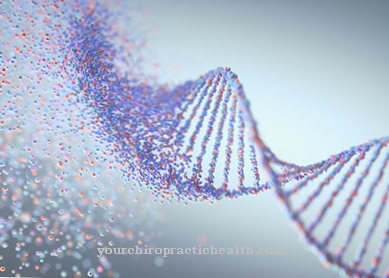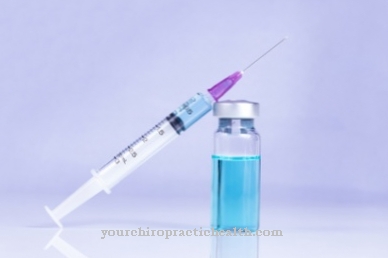As a serious developmental disorder of the brain is the Lissencephaly not curable today. The main therapeutic steps are to relieve symptoms.
What is lissencephaly?

© digital photography - stock.adobe.com
The Lissencephaly is a malformation of the brain. The name of lissencephaly is derived from the Greek words for 'smooth' (lissos) and 'brain' (encephalon).
In the context of lissencephaly, the brain convolutions in an affected person are not fully developed or are completely absent. A completely missing formation of brain convolutions in lissencephaly is also referred to in medicine as so-called agyria; it is characterized among other things by a completely smooth brain surface. If only a few convolutions of the brain are present in the context of lissencephaly, this is referred to as pachygyria. In most cases, lissencephaly leads to severe disabilities in those affected.
Lissencephaly is a developmental disorder of the brain that is relatively unlikely to occur; Experts call probabilities between 1: 20,000 and 1: 100,000. Boys and girls are roughly equally affected.
causes
The cause of one Lissencephaly is a so-called migration disorder (also known as a migration disorder) that affects the nerve cells of the brain in a fetus. This means that in lissencephaly, nerve cells are unable to reach the cerebrum during brain development. This means that connections in the cerebrum (i.e. the uppermost brain layer) can only be formed to a very limited extent.
The development of lissencephaly in a fetus is usually hereditary: the genetic makeup of children with lissencephaly usually shows changes or defects in several genes (also known as mutations). Such mutations can either develop spontaneously or they can be inherited from the parents.
Such inheritance of genetic defects, as the cause of lissencephaly, is autosomal recessive. Among other things, this means that there must be a corresponding change in the genetic make-up of both parents in order to be passed on to the fetus; if only the gene of one parent is affected, the healthy gene of the other parent takes over its function.
If there are no hereditary factors behind lissencephaly, the developmental disorder of the brain can be caused, for example, by various viral infections in the unborn child. Lissencephaly can also be caused by poisoning or circulatory disorders, which in an unborn child can lead to a lack of oxygen supply to the brain during the first three months of pregnancy.
Symptoms, ailments & signs
Lissencephaly can cause a wide variety of symptoms and ailments. Generally, affected children stop developing after infancy and are unable to walk, speak or take care of themselves. This is accompanied by other symptoms, such as hearing and vision disorders, epileptic seizures and convulsions.
As a result of swallowing difficulties, food residues can get into the airways during feeding, which can result in pneumonia. Symptoms such as hoarseness, sore throat and heartburn also occur. In individual cases, lissencephaly patients have a water head. Newborn children also often have a noticeably short, upward-pointing nose and a low birth weight. If lissencephaly is part of a syndrome, there are usually other symptoms.
In isolated lissencephaly, for example, flaccid muscles and muscle cramps can be detected. In Walker-Warburg syndrome, malformations such as cleft lip and palate and hydrocephalus as well as severe mental impairments occur. Shortly after birth, the affected children have difficulty breathing.
The symptoms of lissencephaly appear immediately after birth and get worse over the course of the first few years of life. From the age of two at the latest, parents usually notice developmental disorders before serious complaints and complications finally set in. The symptoms of the disease persist for a lifetime and cannot yet be treated causally.
Diagnosis & course
A suspected diagnosis Lissencephaly can already be possible due to the external appearance of a newborn and due to typical symptoms, such as hearing and sight disorders or epileptic seizures. Occasionally, newborns with lissencephaly also have a water head.
A diagnosis can then be confirmed, among other things, by imaging methods such as MRI (magnetic resonance tomography) or CT (computer tomography). Damaged genetic material in lissencephaly can be detected by a blood test.
A prenatal diagnosis of lissencephaly is possible through procedures such as prenatal MRI, ultrasound, and amniocentesis.
The course of lissencephaly depends on the type of malformation of the brain that is present. Often, children with lissencephaly remain in the mental development stage of infants and have a reduced life expectancy. People with lissencephaly usually need lifelong care and need to be fed, for example.
Complications
As a result of lissencephaly, those affected suffer from various malformations and disorders of the brain. These disorders have a very negative effect on the overall condition of the patient and can lead to serious discomfort and complications. Especially in children, lissencephaly leads to severe developmental disorders and thus to limitations and consequential damage in adulthood.
Those affected suffer from hearing and vision problems. This can also lead to severe restrictions when learning. It is not uncommon for lissencephaly to lead to epilepsy. The malformations in the brain can also lead to paralysis and various disorders of sensitivity. This considerably limits and reduces the patient's quality of life.
Unfortunately, it is not possible to treat the symptoms of lissencephaly. For this reason, only symptomatic treatment is given. However, not all complaints can be restricted so that the disease does not progress positively. As a rule, the patients are not infrequently dependent on the help of other people in everyday life and require various therapies. Parents and relatives can also suffer from psychological complaints and depression.
When should you go to the doctor?
If the child has problems swallowing food or generally shows signs of feeding disorders, the pediatrician should be consulted. Difficulty breathing and symptoms of pneumonia should be clarified in the hospital, as there may be danger to life. Epileptic seizures and hearing or vision disorders should also be investigated and treated quickly. If lissencephaly is indeed the cause, early treatment can significantly improve the child's quality of life. In addition, the support from doctors and nurses is a great relief for the parents.
Therefore, in the event of unusual symptoms or a specific suspicion, the family doctor or pediatrician should be called in. The doctor can diagnose the disease beyond doubt or rule it out and initiate appropriate therapy. Affected children need lifelong support from doctors and physiotherapists. The psychological effects of the illness on the sick and their relatives should be worked through in the context of a suitable therapy. The right doctor to treat lissencephaly is a neurologist. Depending on the symptoms, ophthalmologists and orthopedists, among others, are involved in the therapy.
Treatment & Therapy
A curative therapy (i.e. a cure) of the Lissencephaly is not yet possible according to the current medical status. Treatment steps for lissencephaly therefore mainly consist of alleviating symptoms. Corresponding measures can, for example, consist of targeted physiotherapy and / or individual occupational therapy.
Outlook & forecast
The prognosis of lissencephaly is described as unfavorable. Despite all efforts and medical advances, the malformation of the human brain cannot be cured to this day. The patient lacks convolutions or they were not fully developed in the early development process in the womb. This fact cannot be changed or corrected by researchers after the birth. For this reason, the health impairments remain lifelong.
Doctors focus on relieving existing symptoms and improving the patient's quality of life during medical treatment. Since the disease places a heavy burden on relatives, this must be taken into account. The more stable the social and understanding environment, the better the patient's development. Early exercise programs can help to improve the overall situation. Targeted training of memory activity but also physiotherapeutic treatment methods are used.
In most cases, patients are dependent on daily medical care and drug treatment for life. Mobility is severely restricted due to the health disorders. Improvements are achieved if exercise units are carried out outside of the therapies offered in the area of self-help. Due to the severity of the disease, sequelae and other health disorders are possible in the course of life.
prevention
The possibilities, one Lissencephaly preventing in a newborn are limited. In order to prevent lissencephaly, however, it can be useful to have a consistent prenatal diagnosis (prenatal examinations) carried out, especially in high-risk pregnancies.
In medicine, high-risk pregnancies include pregnancies of women who are older than 35 years and for whom family health problems are known. If lissencephaly is detected during prenatal diagnostics, advice can be given about an abortion.
Aftercare
In most cases, those affected have very few or no follow-up measures available for brain diseases. The brain diseases cannot always be treated, so that such a disease may also lead to a reduced life expectancy for the person affected. An early diagnosis usually has a very positive effect on the further course of this disease and can limit further complications or a further worsening of the symptoms.
Since the brain diseases can also lead to psychological upsets, depression or a changed personality, most patients are also dependent on the support and help of their own family and friends in everyday life. This is especially true when some body functions are restricted by the brain diseases. The further course of the follow-up depends heavily on the exact severity of the disease, so that no general prediction can be made.
You can do that yourself
The possibilities for self-help are very limited with lissencephaly. Despite all efforts, the disease does not allow a cure. The focus is on improving the environment and a healthy lifestyle.
The patient and their relatives should maintain a life-affirming attitude despite the restrictions caused by the disease. Joint activities and a stable social environment are helpful. In addition, a healthy diet with lots of vitamins and fiber is beneficial for the internal defense system. With a balanced food intake, the general well-being increases and the likelihood of further diseases occurring is reduced. The consumption of stimulants such as alcohol or nicotine should be avoided. Adequate exercise and spending time in the fresh air also promote the quality of life. In order to ensure adequate and restful sleep, it is necessary to optimize sleeping conditions. The regeneration processes of the human body are dependent on sufficient recovery phases without interruptions. Therefore, the sleeping pads, the temperature, the length of the night's sleep and the ambient noise should be tailored to the needs of the patient.
There are numerous self-help groups nationwide in which sick people and relatives can exchange ideas. Help, tips for everyday life and emotional support are given there. There is also the possibility of digital exchange via forums on the Internet.

.jpg)

.jpg)













.jpg)







.jpg)


